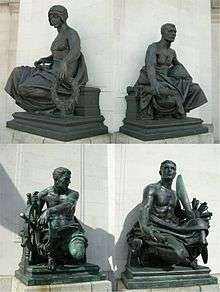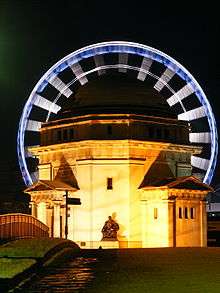Hall of Memory, Birmingham
| Hall of Memory | |
|---|---|
 | |
| General information | |
| Type | War memorial |
| Architectural style | Art Deco |
| Address | Centenary Square |
| Town or city | Birmingham |
| Country | United Kingdom |
| Construction started | 12 June 1923 |
| Opened | 4 July 1925 |
| Cost | £60,000 |
| Height | |
| Height | 17m |
| Roof | 159.64m ASL |
| Technical details | |
| Material | Portland stone |
| Design and construction | |
| Architect |
|
| Main contractor |
|
Listed Building – Grade I | |
| Designated | 27 October 2014 |
| Reference no. | 1244943[1] |
The Hall of Memory in Centenary Square, Birmingham, England, designed by S. N. Cooke and W. N. Twist, is a war memorial erected 1922–25, by John Barnsley and Son, to commemorate the 12,320 Birmingham citizens who died in World War I.[2]
Built directly over a filled-in canal basin of Gibson's Arm,[3] it was the first structure in an area (now occupied by Centenary Square and the International Convention Centre and Symphony Hall) purchased by the council for the creation of a grand civic scheme to include new council offices, the mayor's residence, a public library, and a concert hall. The scheme was abandoned after the arrival of World War II with only half of the planned Baskerville House having been built.

Made from Portland stone, from the Isle of Portland in Dorset, the foundation stone was laid by HRH The Prince of Wales on 12 June 1923 and it was opened by Prince Arthur of Connaught on 4 July 1925 to a crowd of 30,000. Construction had cost £60,000 and was funded through public donations.[4] The four statues around the exterior are by local artist Albert Toft. They represent the Army, the Navy, the Air Force, and Women's Services.[5]

The interior features three carved bas-relief plaques (155 cm x 223 cm) by William Bloye representing three tableaux: Call (departure to war), Front Line (fighting), Return (arrival home of the wounded). These bear inscriptions:
OF 150,000 WHO ANSWERED THE CALL TO ARMS 12,320 FELL: 35,000 CAME HOME DISABLED
AT THE GOING DOWN OF THE SUN IN THE MORNING WE WILL REMEMBER THEM
SEE TO IT THAT THEY SHALL NOT HAVE SUFFERED AND DIED IN VAIN +*+
There is also a roll of honour illustrated by Sidney Meteyard.[6]
The hall was upgraded on 27 October 2014 to a Grade I listed building[1][7] from its previous Grade II.[8]
During the Birmingham Blitz, on the night of 11 December 1940, all but the fine tower and classical west portico of St. Thomas' Church, Bath Row, was destroyed by German bombs. The church was never rebuilt. The First World War Memorial colonnade, which had been built alongside the Hall of Memory in 1925, was relocated there when Centenary Square was laid out 1989. The gardens were re-designed as the St. Thomas' Peace Garden in 1995 in commermoration of the fiftieth anniversary of the end of World War II, as a monument to peace, and as a memorial to all those killed in armed conflict.
References
- 1 2 "English Heritage - Listing".
- ↑ http://www.birmingham.gov.uk/hom
- ↑ Norman Bartlam (2002). Broad Street Birmingham. Sutton Publishing. ISBN 0-7509-2874-3.
- ↑ http://www.birmingham.gov.uk/hom
- ↑ http://www.birmingham.gov.uk/hom
- ↑ "Obituary (Sidney Harold Meteyard)". The Birmingham Post. 1947-04-07.
- ↑ "Four war memorials given Grade I listing for Armistice Day". The Guardian. Retrieved 12 November 2014.
- ↑ Historic England. "Grade II (468884)". Images of England.
- Pevsner Architectural Guides - Birmingham, Andy Foster, 2005, ISBN 0-300-10731-5
- Public Sculpture of Birmingham including Sutton Coldfield, George T. Noszlopy, edited Jeremy Beach, 1998, ISBN 0-85323-692-5
- A History of Birmingham, Chris Upton, 1993, ISBN 0-85033-870-0
External links
| Wikimedia Commons has media related to Hall of Memory, Birmingham. |
- Birmingham City Council page about the Hall of Memory
- Birmingham Open Guides
- Official website of the Hall of Memory in Birmingham
- Entry in the United Kingdom National Inventory of War Memorials
Coordinates: 52°28′46.02″N 1°54′25.31″W / 52.4794500°N 1.9070306°W